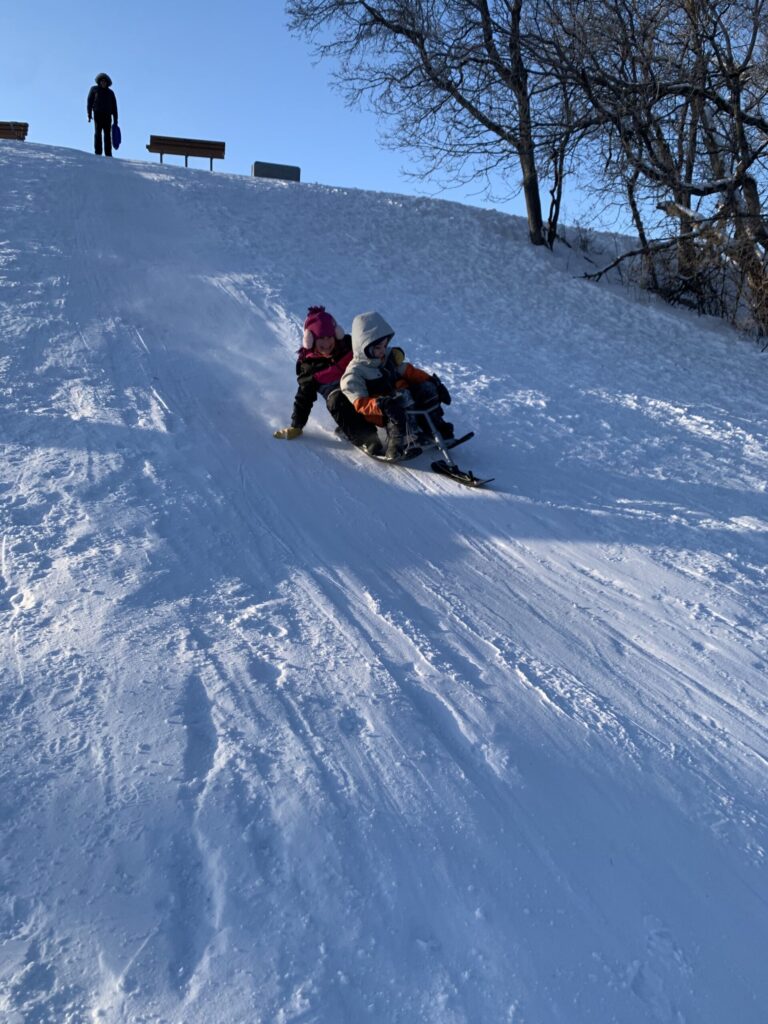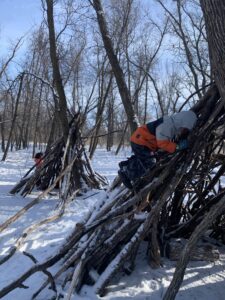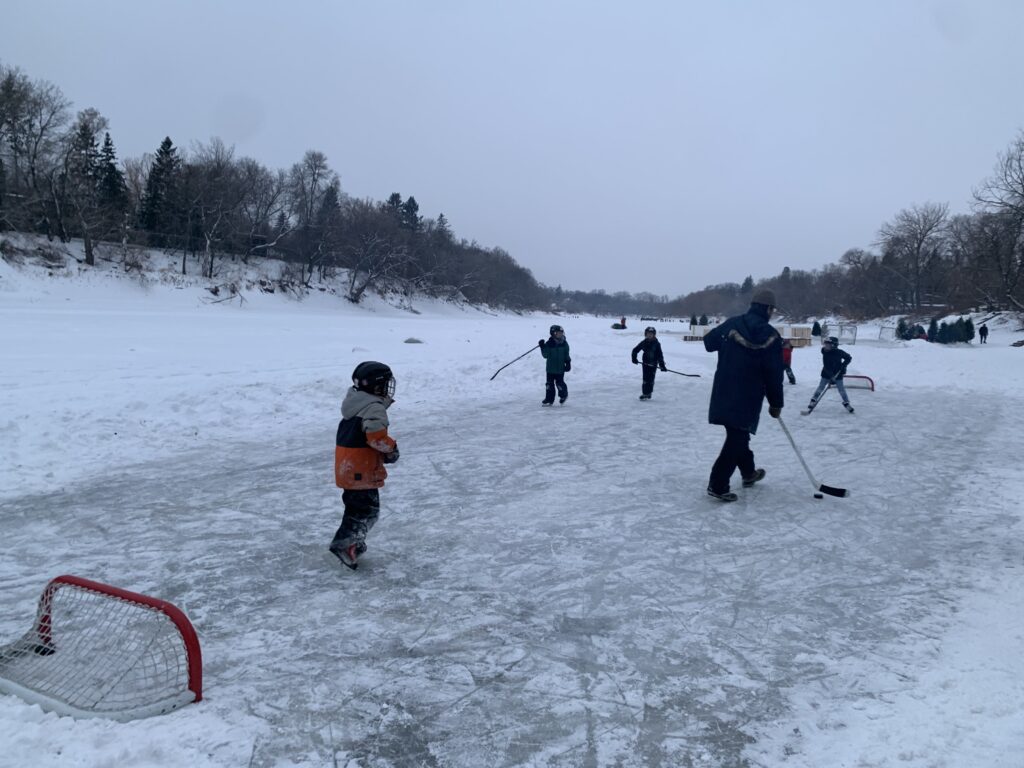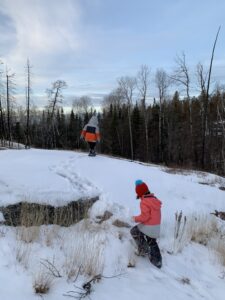Top Pandemic-Survival Tips From a Twin Mom: Get Outside This Winter


By Mira Oberman, Adapted for Saskatchewan by Caitlyn Anhorn
Though we have not had school closures or long periods of super cold weather in the very recent past, we continue to live with the idea that these things aren’t completely out the window for us in Saskatchewan.
In fact, in Manitoba, this was a reality back at the beginning of January. Mira Oberman from CPAWS-Manitoba wrote a blog, titled “How to Survive Yet Another School Closure: Get Outside — The Winter Edition,” from a twin mom perspective. Here is a ‘sister’ blog that Saskatchewan-ize’s Mira’s blog and shares her first-hand experiences, along with her top tips for surviving the pandemic this winter.
Through the blog, Mira hopes to inspire ‘pandemic-stressed parents and children’ to get outside in ALL conditions. Nature has saved her sanity during the pandemic, and it can help your family too.
(Written from Mira Oberman’s perspective – CPAWS MB, with added links from CPAWS SK)
Tip #1: Get Outside. Every Day. No Matter What. Seriously.
As we all go through different periods and reasons for family-isolation, there is a lot of pressure on parents to perform double-duty. Between working from home and helping kids through their day, it’s easy to get sucked into screens all day.
ParticipACTION’s 2020 report card found less than 5% of Canada’s children and teens were meeting physical movement guidelines during the early months of the pandemic, down drastically from 15% in 2019.
Remind yourself: kids have recess three times a day at school for a reason. They need movement breaks. And they need fresh air and exercise.
If you have a yard, help them build a snowman or a fort.
If you have the privilege of flexible work hours (or the burden of job loss) take them for a walk, tobogganing, or even a skate on an outdoor rink at least once and ideally twice a day.
Getting outside will improve their mood (and yours) and help children and teens stay focused when they get back to their remote learning assignments.



Tip #2: Dressing Kids for Winter Fun – It’s All About Layers
The key to enjoying winter activities is to stay warm and dry.
Kids are not very good at telling you when they’re starting to get cold so keep a careful eye on them to watch for signs of frostbite or hypothermia. Be sure to read this guide on cold weather safety from Saskatchewan Health.
Layers are your best friend. Hiking, skiing, skating, and tobogganing is good exercise. You don’t want to get sweaty while you’re moving and then catch a chill when you stop. So be aware of your body temperature and take layers off — or pile them on — as needed.
On warmer days, start with a light puffer jacket or windbreaker supplemented by a sweater or fleece and a long sleeve shirt (a moisture-wicking fabric baselayer of wool or synthetic fibre is best — cotton gets damp). You may overheat in a heavy parka unless it’s very, very cold out.
Kids will absolutely need snow pants to keep them dry as they climb and slide in the snow. Snow pants or windbreaker/shell pants are well worth the investment for parents too. They don’t have to be expensive. They just need to keep your bottom half warm and dry, especially when you sit down for a snack break.
On colder days, make sure all exposed skin is covered. Balaclavas are brilliant for that, and some people will wear ski goggles so they can safely spend more time outside.
A scarf (or two!) is a great way to keep hoods on heads and protect little noses if you don’t have a balaclava. Hats can also be layered for added warmth — I find a wool hat under a windbreaking hood is the best defence.
Garbage mitts are my favourite to keep little hands warm — the exterior leather blocks the wind and traps body heat inside, with the help of some fuzzy fleece. On very cold days, I will add hand and toe warmers (reusable if you can find them!). You can also layer thin gloves under heavy mitts for added warmth and flexibility.
Warm, comfortable, and sturdy boots are a must. You don’t need expensive hiking boots. But you will not enjoy walking through the woods in sopping wet sneakers or leather boots with a high heel.
We recommend getting spikes or a traction device for your shoes for icy conditions. You can find them at Outter Limits in Saskatoon, Fresh Air Experience in Prince Albert or Regina, or even Costco!
Check out Life Outside Gear Exchange in Saskatoon, online, or if they pop up shop in your community for gently used gear in great condition and a cheaper price.
Tip #3: Winter Fun Activities for Kids



The easiest way to get kids active (and wear them out!) in winter is to grab a sled and head to a hill or tobogganing slide. Even on the coldest days of winter break, I kept my seven-year-old twins happy for at least 20 minutes (and often more than 45 minutes) with our beat-up old sleds. Sledding is also a great way for kids to see their friends at a safe social distance.
Skiing and skating require more of an investment in gear and time to learn how to do it. But it’s a great way for parents to also get some exercise and to expand your winter activity options. Optimist Hill in Saskatoon rents skis and offers lessons. The Cameco Meewasin Skating Rink or the Crossmount Cider Company have cute outdoor skating rinks in Saskatoon, along with Wascana Centre Ice or Iceville at Mosaic Stadium in Regina.
Winter hiking is another great alternative. I tried it for the first time last winter and was amazed at how wonderful it was to be out in the woods in winter. I was expecting to be knee-deep in snow but found the trails to be easier to hike than in summer because the hard-packed snow covered up tripping hazards like tree roots.
Start small with easy hikes along the Meewasin trail or at the Northeast Swale in Saskatoon and you’ll be hooked!
Fact #1: Nature Heals — That’s a Fact
Most people don’t need a meta-analysis of scientific research to tell them they feel good when they’re out in the woods or listening to waves lapping on the shore of the lake.
Nature is the perfect antidote to the pandemic. Studies have shown it can:
- Reduce stress
- Improve sleep
- Ease symptoms of depression and anxiety
- Increase happiness and social connectedness
- Boost your immune system
- Lower blood pressure
- Support pain management
- Combat obesity and diabetes
- Reduce symptoms of attention-deficit/hyperactivity disorder
- Improve eyesight
- And so much more.
In fact, PaRx was launched as the first national nature prescription program, and it came to Saskatchewan in July 2021. This just shows how important connecting with nature truly is for our health!



Tip #4: Get Out into True Wilderness as Often as Possible
My friends in Saskatchewan tell me that they love the Northeast Swale. It’s a unique section of native grasslands within the city limits of Saskatoon. The wetlands are home to waterfowl and the grasses to deer and even the occasional moose. But I can still hear the buzz of traffic and the growl of planes landing.
I breathe differently when I’m in true wilderness. So do you! There’s some pretty remarkable science on the benefits of natural sounds — especially when they are free of human-related noise like traffic. Natural soundscapes can reduce stress, lower your heart rate, improve your mood, and even decrease pain.
There are plenty of great spaces within a 10- to 30-minute drive of Saskatoon, Regina, or Prince Albert that you can get out to after work and school wrap up for the day or on the weekend. Cranberry Flats, Beaver Creek, and Little Red are a few favourites so I’ve heard.
If you’ve got a full day to explore, put on a good audiobook (free from the library!) and head to Echo Valley, Pike Lake, or Candle Lake. Many Provincial Parks in Saskatchewan also have exciting activities like crokicurl, skating, snow mazes, snowshoe rentals, cross-country skiing trails, and more. The fun never stops!
Tip #5: A Hike Counts as Home Learning
It took my twins nearly three hours to hike about five kilometres of trails at Oak Hammock Marsh in Manitoba on the first Saturday after home learning began last April.
They stopped to chat with a caterpillar (the first of the season) and to dip their hands in the murky marsh water.
We counted goslings and used a (free!) Audubon app to identify birds (barn swallows, yellow-headed blackbirds, and red-winged blackbirds were easiest to identify; the ducks and shorebirds were too far away to properly identify without our binoculars.)
We tore open wrinkled rose hips to see the seeds and used the (free!) iNaturalist app to identify plants.
This time around, we’ll be looking for animal tracks in the snow and exploring what we can see through the ice of frozen rivers and creeks.
There are lots of ways to turn time outside into learning opportunities.
You can also check out CPAWS-MB Speaker Series webinars on topics like Warming Up to Winter: How to Get Active in the Snow, Birding for Beginners, Chasing the Northern Lights, and The Art of Watercolour: How to Paint Nature to find inspiration on ways to enjoy nature.
Tip #6: What to Pack: Lots and Lots of Snacks



I would lose my mom creds if I didn’t mention snacks. I try to pack light, so typically we do a picnic either along the way or at the trailhead. I also pack water and snacks for the drive.
Here’s what’s in my hiking pack for a typical one- to two-hour winter hike:
- One bottle of water per person. I prefer stainless steel bottles to plastic, even though they are heavier.
- A thermos of hot chocolate to warm us up along the way.
- Three to four snacks per child (two healthy and one to two special treats for motivation) plus some for adults.
- Hand sanitizer.
- Napkins and a pack of tissues (trailhead outhouses are often out of toilet paper.)
- Bandaids, antiseptic spray.
- A bag for garbage. (Leave No Trace)
- Binoculars, a compass and a magnifying glass (to help us explore!)
Here’s what I keep in my car for winter safety when driving outside the city:
- A full tank of gas in case we get stuck or lost.
- A blanket (or two).
- Extra water and snacks.
- A shovel.
- Extra mitts, hats, and socks in case we get wet.
- Read more tips on winter driving from the Government of Canada at this link.
Tip #7: Put Your Own Oxygen Mask On First
It has been a really long pandemic. Especially for parents. Too many of us have lost loved ones. Too many of us have lost their jobs or seen their wages plummet painfully. We are all missing our friends and our families.
Something I learned very early into being a twin mom was that I cannot take care of my kids if I don’t take care of myself. As they say in those boring airline safety videos (don’t you miss those boring airline safety videos?), you need to put your own oxygen mask on first.
Getting outside will help you manage your own stress and anxiety. So will managing your own expectations of yourself. Life isn’t always Instagram or Pinterest-worthy. You will have bad days. You will make mistakes. Your kids will drive you crazy.
Be kind to yourself. Find help if you need it. There is a light at the end of this pandemic tunnel.
